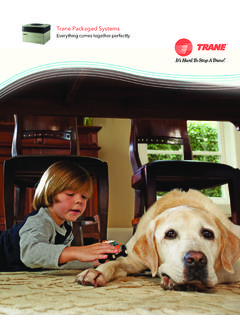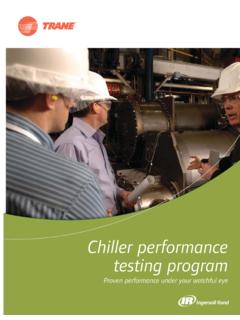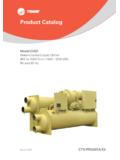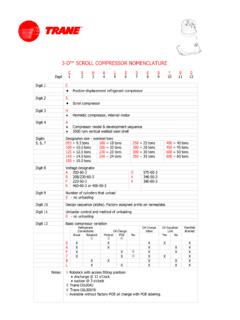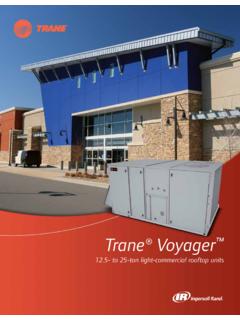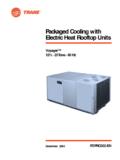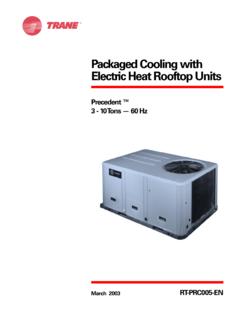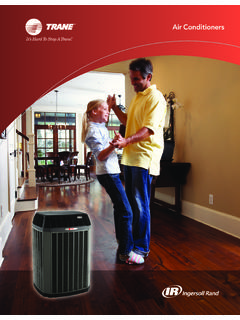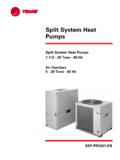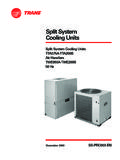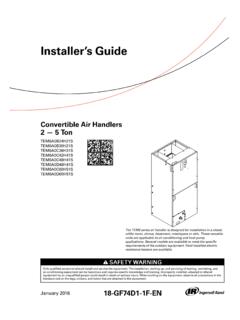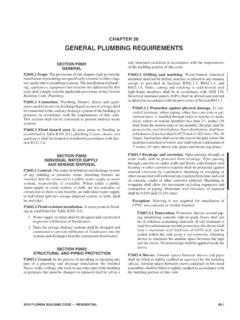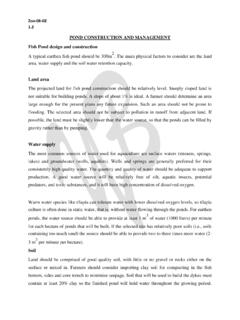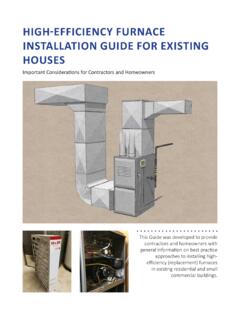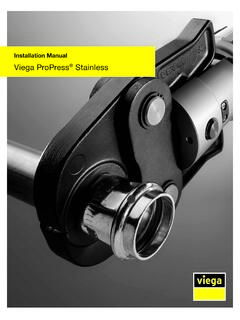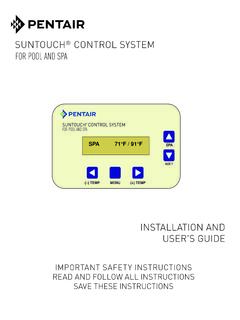Transcription of Installer’s Guide Heat Pumps - Trane
1 18-BC95D1-4-ENALL phases of this installation must comply with NATIONAL, STATE AND LOCAL CODESIMPORTANT This Document is customer property and is to remain with this unit. Please return to service informa-tion pack upon completion of PumpsThese instructions do not cover all variations in systems or provide for every possible contingency to be met in connection with the installation. Should further information be desired or should particular problems arise which are not covered sufficiently for the purchaser s purposes, the matter should be referred to your installing dealer or local : The manufacturer recommends installing only approved matched indoor and outdoor systems.
2 All of the manufacture s split systems are AHRI rated only with TXV/EEV indoor systems. Some of the benefits of installing approved matched indoor and out-door split systems are maximum efficiency, optimum performance and the best overall system s GuideTable of ContentsSection 1. Safety ..2 Section 2. Unit Location 3. Unit Preparation ..5 Section 4. Setting the Unit ..5 Section 5. Refrigerant Line Considerations ..6 Section 6. Refrigerant Line Routing ..7 Section 7. Refrigerant Line Brazing ..8 Section 8. Refrigerant Line Leak Check ..10 Section 9. Evacuation.
3 11 Section 10. Service Valves ..11 Section 11. Electrical - Low Voltage ..12 Section 12. Electrical - High Voltage ..15 Section 13. Start Up ..16 Section 14. System Charge Adjustment ..17 Section 15. Checkout Procedures and Troubleshooting ..232 18-BC95D1-4-ENSection 1. Safety WARNING!This information is intended for use by individuals possessing adequate backgrounds of electrical and mechanical experience. Any attempt to repair a central air conditioning product may result in personal injury and/or property damage.
4 The manufacture or seller cannot be responsible for the interpretation of this information, nor can it assume any liability in connec-tion with its units use R-410A refrigerant which operates at 50 to 70% higher pressures than R-22. Use only R-410A approved service equipment. Refrigerant cylinders are painted a Rose color to indicate the type of refrigerant and may contain a dip tube to allow for charging of liquid refrigerant into the sys-tem. All R-410A systems use a POE oil that readily absorbs moisture from the atmosphere. To limit this hygroscopic action, the system should remain sealed whenever possible.
5 If a system has been open to the atmosphere for more than 4 hours, the compressor oil must be replaced. Never break a vacuum with air and always change the driers when opening the system for component replacement. For specific handling concerns with R-410A and POE oil reference Retrofit Bulletins SS-APG006-EN and APP-APG011-EN or caution should be exercised when opening the Liquid Line Service Valve. Turn counterclockwise until the valve stem just touches the rolled edge. No torque is required. Failure to follow this warning will result in abrupt release of system charge and may result in personal injury and /or property CONTAINS R-410A REFRIGERANT!
6 R-410A operating pressures exceed the limit of R-22. Proper service equipment is required. Failure to use proper service tools may result in equipment damage or personal ONLY R-410A REFRIGERANT AND AP-PROVED POE COMPRESSOR OIL. WARNING! WARNING!LIVE ELECTRICAL COMPONENTS!During installation, testing, servicing, and trouble-shooting of this product, it may be necessary to work with live electrical components. Failure to follow all electrical safety precautions when exposed to live electrical components could result in death or serious injury. WARNING!If using existing refrigerant lines make certain that all joints are brazed, not soldered.
7 CAUTION!Scroll compressor dome temperatures may be hot. Do not touch the top of compressor; it may cause minor to severe burning. CAUTION! WARNING!18-BC95D1-4-EN 3 DHW50 Max VerticalChangeStandardLine Set 150 Max TOTAL Line Length50 Max VerticalChangeSection 2. Unit Location Unit Dimensions and Refrigerant Piping LimitsTable mounting the outdoor unit on a roof, be sure the roof will support the unit s weight. Properly selected isolation is recommended to alleviate sound or vibration transmission to the building structure. Unit Dimensions and WeightModelsH x D x W (in)Weight* (lb)4 TWR4018G29 x 26 x 291414 TWR4024G29 x 30 x 331634 TWR4030G29 x 34 x 372164 TWR4036G33 x 34 x 371984 TWR4042G29 x 34 x 372164 TWR4048G33 x 34 x 372664 TWR4060G45 x 34 x 37278* Weight values are The maximum TOTAL length of refrigerant lines from outdoor to indoor unit should NOT exceed 150 feet (including lift).
8 2. The maximum vertical change should not exceed 50 Service valve connection diameters are shown in Table : For other line lengths, Refer to Refriger-ant Piping Application Guide , SS-APG006-EN or Refrigerant Piping Software Program, 32-3312-03 (or latest revision).4 18-BC95D1-4-ENMin. 12 to ShrubberyAvoid Install Near BedroomsMin 5 UnrestrictedAccess PanelMin 3 Unrestricted Suggested Locations for Best ReliabilityMin.
9 12 to ShrubberyMin. 12 to Cold Climate Considerations Ensure the top discharge area is unrestricted for at least five (5) feet above the (3) feet clearance must be provided in front of the control box (access panels) and any other side requiring service. It is not recommended to install in a location where noise may distract the building occu-pants. Some examples of these types of loca-tions are sleeping quarters and by windows of a living area. Please discuss location with the building owner prior to installation. NOTE: It is recommended that these precau-tions be taken for units being installed in areas where snow accumulation and prolonged below freezing temperatures occur.
10 Units should be elevated 3-12 inches above the pad or roof top, depending on local weather. This additional height will allow drainage of snow and ice melted during defrost cycle prior to its refreezing. Ensure that drain holes in unit base pan are not obstructed preventing draining of defrost water. If possible, avoid locations that are likely to accumulate snow drifts. If not possible, a snow drift barrier should be installed around the unit to prevent a build-up of snow on the sides of the unit. Min. 12 Snow Barrier3-12 ElevationSnow LegsPadAvoid locations such as near windows where condensation and freezing defrost vapor can annoy a the outdoor unit a minimum of 12 from any wall or surrounding shrubbery to ensure adequate unit location must be far enough away from any structure to prevent excess roof runoff water or icicles from falling directly on the unit.
